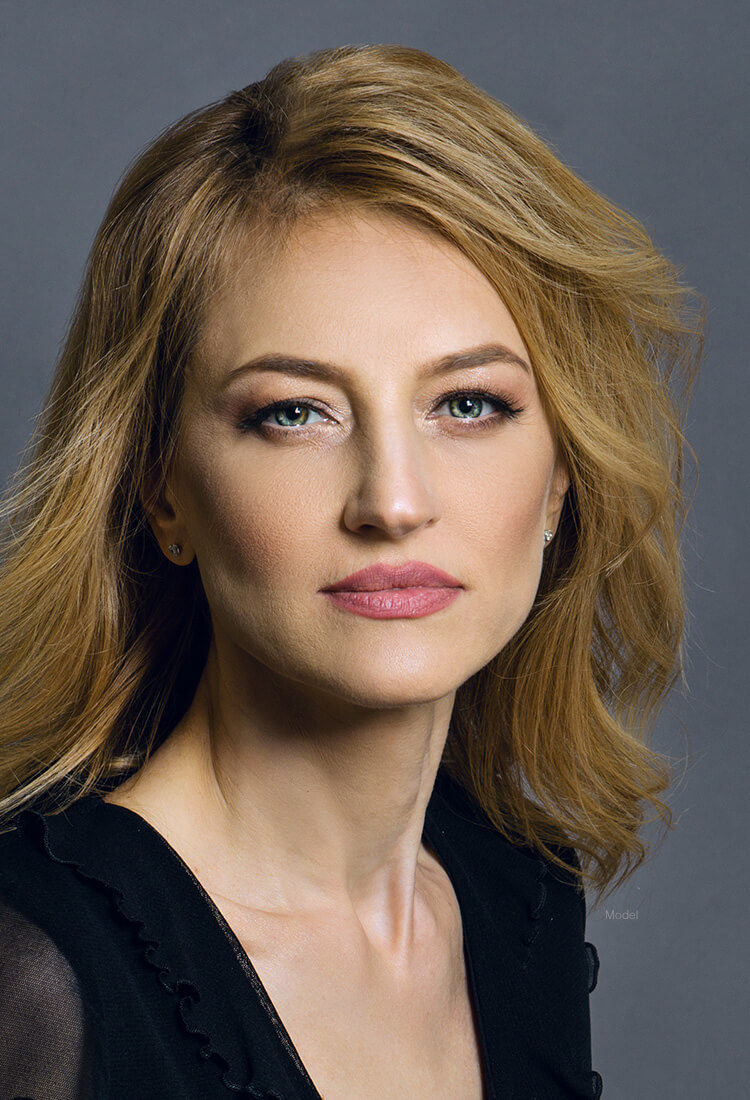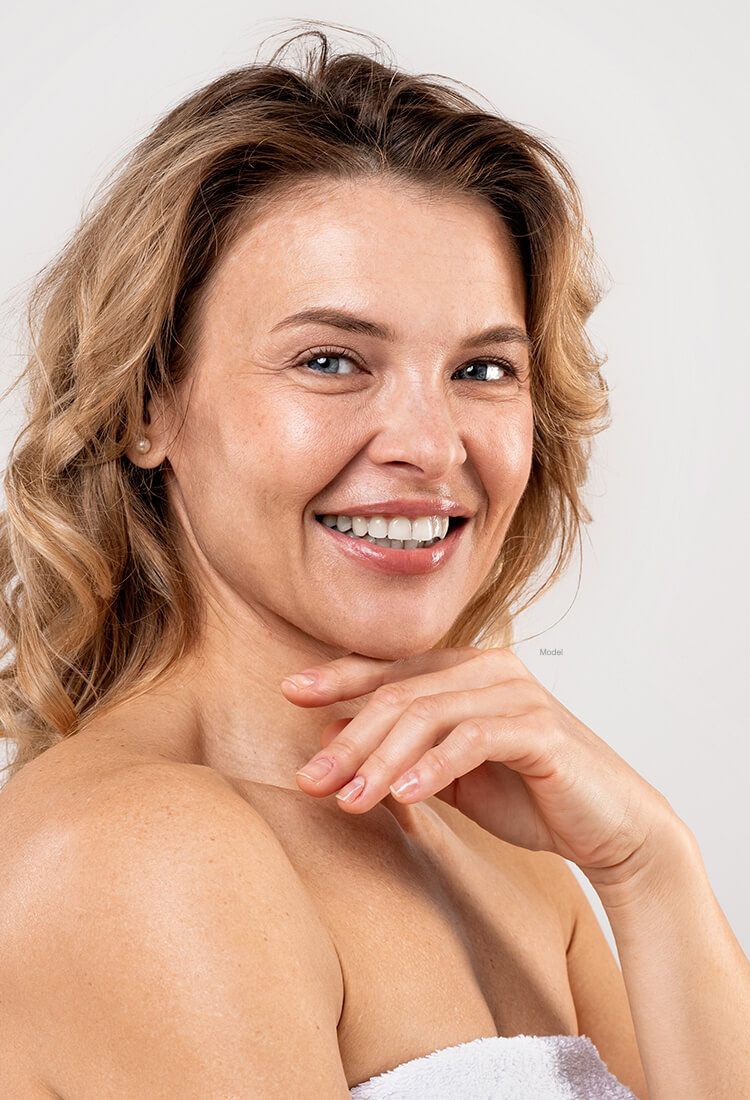Facelift Surgery in Dallas, TX
Facelift and neck lift procedures can bring back the youthful contours that are lost over time. Personal satisfaction is achieved, and confidence is restored following these procedures.
Our faces expose our moods, emotions, and expression. Since our society has always emphasized beauty and youthful appearances, cosmetic surgical procedures of the face and neck have become more common than ever. Though most patients seeking facial rejuvenation procedures do so for personal satisfaction, many choose face and neck lift surgery to stay competitive professionally.
Facial aging occurs progressively and gradually, typically following predictable patterns related to genetics, gender, ethnicity, and environmental exposure. There is general atrophy or thinning of all tissue planes in the face and neck, including the skin, muscle, connective tissues, fat, and bone. The result is a general hollowing in the upper face, cheek, and around the eyes. The thinning tissues are less capable of maintaining support, resulting in a sagging, tired-looking appearance. Additionally, fullness in the upper face has descended to a lower position on the cheek, jowl, and neck.
A modern facelift (rhytidectomy) corrects the cumulative effects of facial aging by restoring the face’s youthful anatomy and re-establishing stability in the deeper planes of the face and neck, thus re-establishing the patients’ normal anatomy with a natural, youthful appearance.
By following these principles of the modern facelift, the face looks natural, soft, and rested, not strained, unnatural, or pulled.

Facelift Procedure Options:
- Traditional facelift
- Lower facelift
- Autologous fat grafting
- Neck lift only
What Can a Facelift Improve?
- Loose underlying tissue – Importantly, a modern facelift is performed in a deeper plane to release and elevate these tissues, recreating the original tension that allows for support. Tension is not placed in the skin itself, which was the cornerstone of older techniques that produce tight and unnaturally strained appearances.
- Sagging skin – In addition to tightening the underlying tissue, stretched and weak facial skin is trimmed to eliminate fine lines, wrinkles, and deep creases. With modern-day techniques, minimal tension is placed on the skin. The result is a balanced, soft, unrestrained appearance.
- Loss of facial volume – Areas where atrophy of tissue planes leads to volume loss, and thus loss of contour, are improved by replacing the missing volume using autologous grafts, usually in the form of fat grafting.

Am I a Candidate for a Facelift?
While most patients seeking facial rejuvenation procedures do so for personal satisfaction, many feel their livelihood depends on it, often choosing cosmetic face and neck lift surgery to stay competitive in the most conservative business settings.
You may be a good candidate for a facelift if you are in good health, don’t smoke (or are willing to quit), and desire the following results:
- Tighter, younger-looking skin on the face and neck
- Significantly less wrinkles
- More fullness
- Increased confidence
What Is Discussed During My Facelift Consultation?
You can expect to have a complete evaluation of your face and neck, ask any questions you may have, and get the answers you need to make an informed decision about facelift surgery.
Dr. Carpenter will recommend an individualized treatment plan that meets your cosmetic goals. Dr. Carpenter performs the entire procedure.

How Is a Facelift Performed?
A facelift is designed to correct the cumulative effects of facial aging by restoring the youthful anatomy of facial and neck structures while smoothing and tightening the skin.
Most face and neck lifts utilize general anesthesia, though local anesthesia with sedation can be used for more limited or revisional procedures.
In our practice, facelift procedures are performed under general anesthesia by MD anesthesiologists. All surgical procedures are performed in licensed and accredited surgery centers specializing in outpatient and overnight surgical procedures. Our surgery centers are state-of-the-art and provide seamless delivery of excellence in plastic surgery care.
The patient experience begins with a thorough review of the surgical plan, “the blueprint,” and aftercare instructions with Dr. Carpenter. The surgical procedure is performed entirely and only by Dr. Carpenter.
Dr. Carpenter performs facelift surgery by completing the following steps:
- Incisions are made near the temple and ear.
- Sagging tissues under the skin are accessed and elevated to a more youthful position.
- The skin is pulled upward and outward for a tighter but still natural look.
- Incisions are methodically sutured to reduce the appearance of scars.
A modern facelift focuses on the deeper facial planes to place tension where it belongs and not in the skin, and volume loss can be improved by using fat grafting. These techniques help prevent a too-tight and unnaturally strained result.
Addressing the neck is the cornerstone of an effective youthful result with facelift procedures. Several factors contribute to a heavy and loose neck appearance, and these are evaluated preoperatively to determine the exact procedures needed.


Fat planes are adjusted as necessary, and the broad muscle in the neck, known as the platysma, is tightened. These maneuvers help recreate a sharp neck crease and jawline. Ultimately, the platysma muscle is elevated in a true vertical vector, helping to reveal a sharper outer jawline, correction of vertical bands in the neck, and reversal of the jowls.
Occasionally, an isolated lower neck lift procedure, without additional procedures, can suffice in recreating a youthful neck. More commonly, however, a more substantial and balanced lift is achieved by adding procedures involving the mid and upper face.
Combining Other Procedures With Your Facelift
Because facelift surgery generally focuses on the mid to lower face, you may benefit from combining this procedure with eyelid surgery for heavy upper eyelids and puffy lower lids, a brow lift to address a sagging brow or lax forehead, and chin and cheek augmentation to counteract severe volume loss.

What Happens After a Facelift?
Post-surgical dressings are placed, and the patient is transferred to a private room to recover with one-on-one nursing care. While some patients are treated on an outpatient basis, most stay overnight for optimal comfort. Dressings are changed, and the patient is discharged to go home the following morning.
Post-surgical instructions are provided upon discharge, and our concierge-level follow-up care and post-procedure management help ensure patient comfort and desired results. You can expect to see Dr. Carpenter again four to six days after surgery.
What Is Recovery Like After Facelift Surgery?
Dr. Carpenter has designed protocols and guidelines to help reduce the swelling and discomfort that typically occurs after a facelift. These early effects are tolerated, especially when expected and arranged for.
Activities are limited for three to five days after surgery. Patients are usually relatively mobile within seven to 10 days and can resume social and work responsibilities.
Most patients are quite comfortable within two weeks.
For our patients privacy, we do not show facelift photos on our website. But, we are more than happy to show you results during your consult with Dr. Carpenter.
Are You Ready For Your Facelift?
Contact our Dallas plastic surgery practice by calling (214) 827-8407 to request your in-depth facelift consultation with Dr. Carpenter.
How Much Is a Facelift in Dallas, TX?
The cost of a facelift in Dallas, Texas, will depend on the techniques used and the extent of correction desired. You will receive an accurate estimate during your initial consultation that will include surgery, anesthesia, and fees based on your tailored surgical treatment plan.
Facelift FAQ
-
Facelifts usually take about two to three hours and are often performed as outpatient surgery; however, some patients choose to stay overnight for additional nursing care.
-
Surgical scars are located discreetly within the folds around the ear and temple. These mature over a few months, resulting in discreet lines that are often difficult to see.
Most hairstyles hide facelift scars, and Dr. Carpenter uses unique techniques to minimize their appearance.
-
You can expect to experience temporary discomfort, especially at the incision sites, but it can be managed with prescription or over-the-counter medication.
-
You may experience a degree of bruising and swelling following your facelift surgery. Significant swelling should fade within a week, while bruising may last up to three weeks.
-
Everyday activities, including work, can usually be resumed within two weeks.
-
Like any surgery, there are some risks involved with receiving a facelift. If you smoke, you should quit weeks before and after surgery to reduce these risks.
- Excess bleeding
- Infection
- Poor incision healing
Nerve damage can also occur. Dr. Carpenter will explain the risks and complications of this surgery during your consultation.
-
A facelift usually lasts seven to 10 years. These results can be shorter or longer depending on how you care for and maintain your results following surgery.
